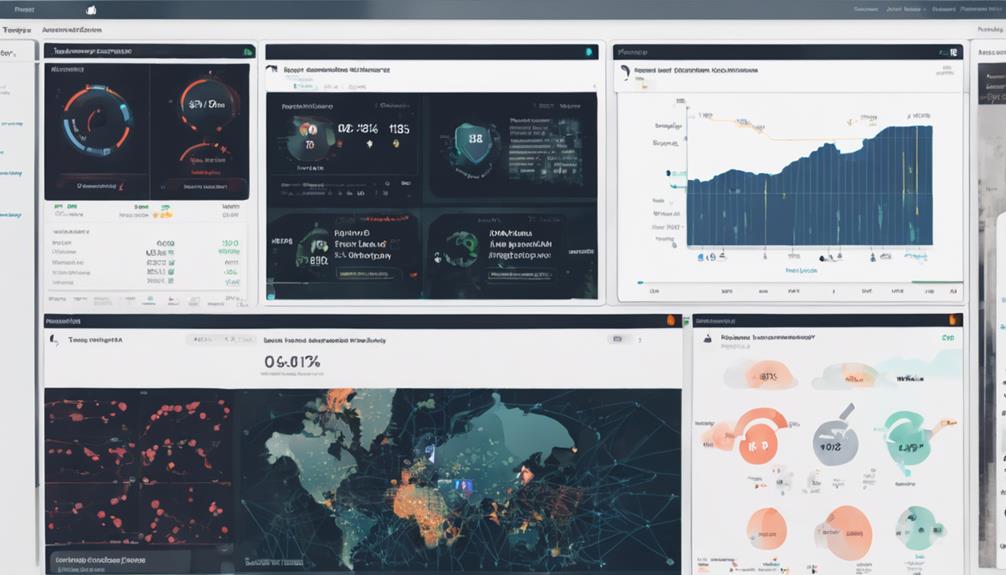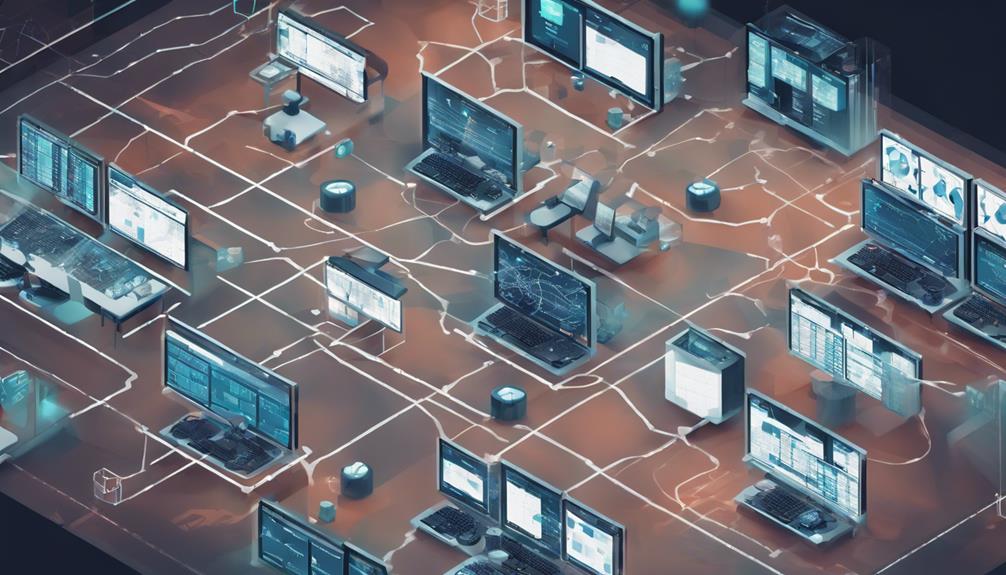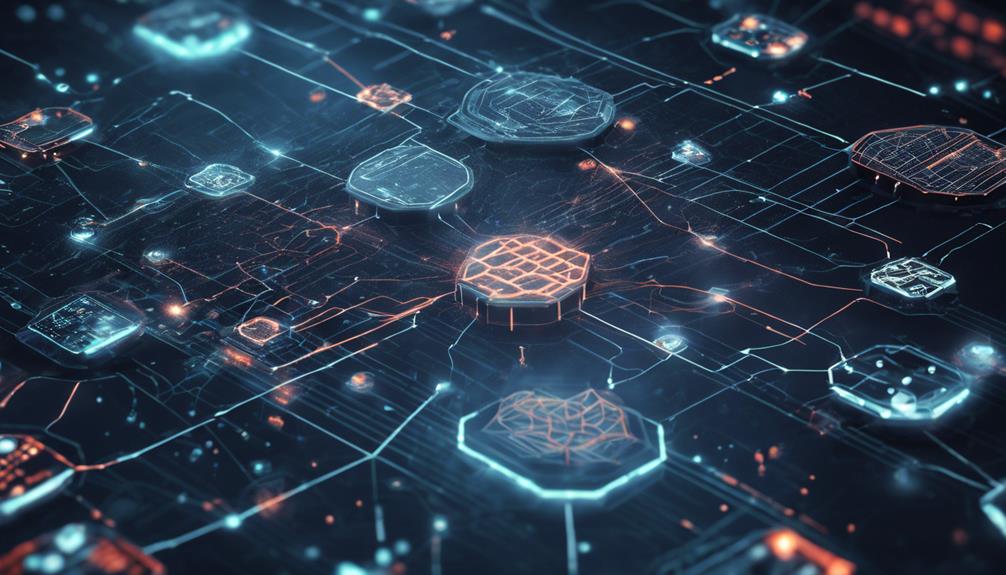Advanced Cybersecurity
Ransomware Attacks: Prevention & Mitigation Tips
Explore expert tips for ransomware attacks: prevention and mitigation strategies to secure your data and fend off cyber threats effectively.

Ransomware attacks continue to pose a significant threat to individuals and organizations. In 2021 alone, there was approximately one ransomware attack every 11 seconds, resulting in billions of dollars in damages1. These malicious attacks have the potential to cripple businesses, disrupt critical services, and compromise sensitive data. It is crucial to implement effective prevention and mitigation strategies to safeguard data and fend off cyber threats.
Understanding the nature of ransomware is the first step in protecting against these attacks. Ransomware is a sophisticated type of malware that encrypts data and holds it hostage until a ransom is paid2. It often targets individuals or businesses that are likely to pay the demanded sum to recover their data. Ransomware attacks can have devastating consequences, particularly for organizations that rely on sensitive information to operate effectively.
Various attack vectors are used by ransomware attackers to exploit vulnerabilities and gain unauthorized access. These include internet-facing vulnerabilities, compromised credentials, phishing, precursor malware infection, advanced social engineering, and targeting third parties and managed service providers1. Awareness and education are crucial to prevent these attacks. Regular employee training in cybersecurity awareness can help individuals identify and avoid potential threats.
One of the most important mitigation strategies against ransomware is to maintain offline, encrypted backups of critical data13. By keeping copies of important data on external hard drives or secure cloud servers, organizations can easily restore their files in the event of an attack. Regularly testing the availability and integrity of backups is critical to ensure their efficacy.
Another important measure is to keep all systems and software updated. Cybercriminals often exploit vulnerabilities in outdated systems to launch ransomware attacks. Regularly updating operating systems, web browsers, and antivirus software is essential to protect against these attacks12.
Installing comprehensive antivirus software and firewalls is also crucial for defending against ransomware. Antivirus software can scan for and detect cyber threats, while firewalls act as a first line of defense against external attacks1. Configuring firewalls correctly and being cautious of fake virus detection alerts are important practices to enhance cybersecurity.
Network segmentation can be an effective strategy in containing ransomware and preventing its spread across a network. By dividing the network into smaller subnetworks and implementing separate security controls, organizations can limit the impact of ransomware attacks1.
Email remains a common vector for ransomware attacks, and protecting against them requires caution. Vigilance when opening emails from unknown senders and avoiding clicking on suspicious attachments or links is crucial. Employing email authentication protocols such as SPF, DKIM, and DMARC can provide additional protection against phishing attempts and verify the authenticity of emails12.
Limiting user access privileges is another important security measure to prevent the spread of ransomware within organizations. Implementing the principle of least privilege ensures that users only have access to the data and resources necessary for their roles. Role-based access control policies can further enhance security by defining user permissions based on job responsibilities1.
In conclusion, ransomware attacks pose a significant risk to individuals and organizations, but implementing prevention and mitigation strategies can greatly reduce this risk. By maintaining offline backups, keeping systems updated, installing comprehensive security measures, practicing network segmentation, being cautious with emails, and limiting user access privileges, organizations can strengthen their defenses against ransomware attacks. Regular education and training in cybersecurity awareness are also vital to prevent these attacks13.
Key Takeaways:
- Implementing effective prevention and mitigation strategies is crucial to safeguard against ransomware attacks.
- Maintaining offline, encrypted backups of critical data is essential to restore files in the event of an attack.
- Regularly updating systems and software helps protect against vulnerabilities exploited by ransomware attackers.
- Installing comprehensive antivirus software and firewalls enhances cybersecurity defenses.
- Limiting user access privileges and practicing the principle of least privilege reduces the spread of ransomware within organizations.
What is Ransomware?
Ransomware is a sophisticated type of malware that encrypts data and holds it hostage until a ransom is paid. Cybercriminals often target individuals or businesses that are likely to pay the demanded sum to recover their data. Ransomware attacks can have devastating consequences, particularly for organizations that rely on personally identifiable information and sensitive data to operate.
It is crucial to be aware of common infection methods used by cybercriminals to distribute ransomware. These methods include:
- Phishing emails: Malicious emails disguised as legitimate correspondence, tricking users into opening attachments or clicking on links that execute the ransomware.
- Drive-by downloads: Infecting systems when users visit malicious websites or unknowingly download malware.
- System vulnerabilities: Exploiting security weaknesses in outdated software or operating systems to gain unauthorized access.
Ransomware attacks can disrupt business operations, compromise sensitive information, and result in significant financial losses. Organizations must implement robust security measures and educate users to prevent falling victim to these damaging cyber threats.
Implementing preventive measures and understanding the impact of ransomware attacks is crucial in today’s cyber landscape. According to statistical data2, ransomware has become increasingly impactful, with malicious actors actively targeting organizations of all sizes. The updated ransomware guide, based on insights from the Joint Ransomware Task Force and contributions from CISA, MS-ISAC, NSA, and FBI, offers valuable recommendations for protecting against ransomware.
Types of Ransomware
Ransomware attacks come in various forms, each with its own characteristics and modes of operation. Understanding the different types of ransomware can help individuals and organizations better protect themselves against these malicious threats.
Encryption Ransomware: One prevalent type of ransomware is encryption ransomware, which encrypts files on a device, making them inaccessible without a decryption key. This form of ransomware seeks to extort victims by demanding a ransom in exchange for the decryption key. It is estimated that there was approximately one ransomware attack every 11 seconds in 2021, resulting in almost $20 billion in damages4.
Lockers Ransomware: Another type of ransomware is lockers ransomware. This variant restricts access to a user’s computer, essentially locking them out of their system until the ransom is paid. Lockers ransomware takes control of the entire device, making it unusable until the victim complies with the attacker’s demands.
Scareware: Scareware is a form of ransomware that tries to deceive victims into paying a ransom by creating false security threats. This type of ransomware displays alarming messages on an infected device, tricking users into believing their system is compromised. Scareware attempts to pressure victims into purchasing unnecessary software or services to mitigate non-existent threats.
Doxware/Leakware: Doxware, also known as leakware, takes ransomware attacks to a new level by threatening to leak sensitive information unless the ransom is paid. In addition to encrypting files, doxware exfiltrates data from the victim’s device and holds it hostage. This double extortion tactic has become increasingly prevalent among malicious actors, who exploit the fear of data breaches to extort victims2.
These different types of ransomware highlight the evolving tactics employed by cybercriminals to exploit vulnerabilities and extort their victims. It is essential for individuals and organizations to stay informed about these threats and implement robust cybersecurity measures to defend against them.
Ransomware Statistics
| Statistic | Source |
|---|---|
| In 2021, there was one ransomware attack every 11 seconds, resulting in nearly $20 billion in damages | 4 |
| 54% of managed service providers (MSP) reported phishing as the top ransomware delivery method in 2020 | 4 |
| Phishing scams were listed as the top cybercrime in 2020 by the Federal Bureau of Investigation (FBI), causing over $4.2 billion in loss or theft | 4 |
Understanding the different types of ransomware and staying informed about the latest trends and statistics is crucial in developing effective prevention and mitigation strategies against these cybersecurity threats. By implementing robust security measures, organizations can minimize the risk of falling victim to ransomware attacks and protect their valuable data.
Backup Your Data
Regularly backing up your data is one of the most effective ways to mitigate the impact of a ransomware attack. By keeping copies of your important data on external hard drives or cloud servers, you can easily restore your files in the event of an attack.
The 3-2-1 backup rule is a recommended approach, which involves having three copies of your data on two different storage types, with one copy stored offline5. This strategy ensures that even if one backup fails or becomes compromised, you have alternative copies that are readily accessible. It is important to choose reliable external hard drives with sufficient storage capacity to accommodate your data.
Cloud servers are another secure option for data backup. Cloud storage provides the advantage of off-site storage, protecting your data from physical risks such as fire, theft, or natural disasters. Additionally, cloud servers often have built-in security measures and encryption protocols to guard against unauthorized access or data breaches.
When selecting a cloud server provider, consider factors such as storage capacity, data transfer speeds, and service reliability. Cloudian HyperStore is an example of a massive-capacity object storage device designed specifically for resilient backup activities, offering storage capacities of up to 1.5 Petabytes5. It is crucial to choose a cloud server provider that aligns with your data backup needs and ensures the safety and accessibility of your stored data.
In addition to choosing the right backup method, it is essential to regularly test your backups to ensure their efficacy6. Periodic backup testing helps identify any inconsistencies or errors in the backup process and allows for adjustments to be made to improve data recovery capabilities. Annual tests are common for companies, with additional tests conducted as needed when there are significant changes to hardware or software solutions.
By implementing a robust backup strategy, you can minimize the impact of a ransomware attack and ensure the availability of your critical data. Remember to adhere to the 3-2-1 backup rule, evaluate cloud server options, and regularly test your backups to maintain a strong defense against ransomware threats.
Keep All Systems and Software Updated
Ensuring that all systems, including operating systems, web browsers, and antivirus software, are kept up to date is essential in the fight against ransomware. Cybercriminals often target outdated systems because they are more vulnerable to security breaches and attacks. For instance, the infamous WannaCry ransomware attack in 2017 specifically targeted computers with outdated versions of Microsoft Windows, exploiting known vulnerabilities7. By promptly applying patches and updates, individuals and organizations can effectively protect their systems from these types of attacks.
Regular software updates play a vital role in closing security gaps that can be exploited by threat actors. Cyber threats and attack techniques are constantly evolving, and software developers release updates to address these emerging risks. By keeping software up to date with the latest security patches, individuals and organizations can ensure that their systems are equipped with enhanced defenses against ransomware and other cyber threats78.
Outdated legacy systems present an increased risk of falling victim to ransomware attacks. These systems, whether in use by individuals or businesses, often lack the necessary security measures and may have known vulnerabilities. By regularly updating and upgrading these systems, users can minimize their exposure to ransomware and strengthen their cybersecurity defenses78.
In addition to operating system and software updates, it is crucial to keep antivirus software up to date. Antivirus programs play a critical role in detecting and blocking ransomware and other malware. Regular updates ensure that the antivirus software has the latest virus definitions and threat intelligence to effectively identify and neutralize potential threats7.
Benefits of System Updates and Software Patches:
1. Enhanced Security: System updates and software patches often include bug fixes and security enhancements that address known vulnerabilities and protect against emerging threats78.
2. Protection Against Exploits: Outdated systems are more susceptible to exploit kits and methods used by cybercriminals. By keeping systems up to date, individuals and organizations can minimize the risk of attacks and potential damage caused by ransomware78.
3. Improved Performance: System updates and software patches often include performance optimizations that enhance the overall user experience and efficiency of the system7.
4. Compatibility: System updates and software patches ensure compatibility with the latest applications and technologies, reducing the risk of compatibility issues that could lead to system vulnerabilities7.
5. Confidence and Peace of Mind: By regularly updating systems and applying software patches, individuals and organizations can have greater confidence in their cybersecurity posture and enjoy peace of mind, knowing that they have taken proactive measures to protect against ransomware attacks7.
Install Antivirus Software & Firewalls
Comprehensive antivirus software and firewalls are essential components in safeguarding against ransomware attacks and protecting sensitive data from cyber threats. Antivirus software plays a crucial role in scanning and detecting potential malware and malicious activities, ensuring early detection and prevention of ransomware infiltrations. Additionally, firewalls act as the first line of defense by monitoring and filtering incoming and outgoing network traffic, blocking unauthorized access attempts, and controlling data flow.
When selecting antivirus software, it’s vital to choose a reputable and reliable solution that offers robust real-time protection against various types of malware, including ransomware. A reliable antivirus program should include features such as antivirus scanning, anti-malware protection, and web browser security, among others, to provide comprehensive defense against cyber threats.
Furthermore, firewalls offer an additional layer of protection by actively monitoring network traffic and enforcing security policies. Firewalls can be configured to block unauthorized access attempts and restrict traffic to known malicious IP addresses, reducing the risk of ransomware attacks. Additionally, firewalls can impose restrictions on specific ports commonly targeted by ransomware, such as port 445, limiting the potential entry points for attackers.
Implementing both antivirus software and firewalls in tandem strengthens the overall cybersecurity posture and significantly reduces the risk of ransomware infections and data breaches.4
Configuring Firewalls Correctly
To ensure the effectiveness of firewalls, it is essential to properly configure them based on specific security requirements. Incorrect firewall configurations can leave vulnerabilities that can be exploited by cybercriminals.
Configuration best practices for firewalls include:
- Reviewing and updating default firewall settings to align with security policies and guidelines.
- Implementing rule-based and application-level firewalls to provide granular control over network traffic and filter out potential threats.
- Regularly updating firewall firmware and software to address known vulnerabilities and ensure the latest security patches.
- Enabling logging and monitoring features to detect suspicious activities and potential security breaches.
- Conducting regular firewall audits and penetration testing to identify and address any security gaps.
By following these firewall configuration best practices, organizations can maximize their ransomware defense capabilities and protect their valuable data from unauthorized access and potential ransomware attacks.9

Network Segmentation
Network segmentation is a vital strategy for effectively containing ransomware attacks and minimizing their impact on an organization’s infrastructure4. By dividing the network into smaller subnetworks or segments, distinct security controls can be implemented to isolate potential threats and prevent their spread across the entire network.
When implementing network segmentation, organizations can establish different levels of access privileges and security controls based on the sensitivity and criticality of the data within each segment. This approach ensures that even if one segment is compromised by ransomware, the other segments remain protected, limiting the potential damage and enabling security teams to respond and mitigate the threat effectively.
With network segmentation, security teams gain valuable time to identify, analyze, and remove the ransomware infection from the affected segment. This reduces the overall impact of the attack and allows for a more targeted and efficient response4. Simultaneously, segmentation enables organizations to monitor and defend against ransomware more effectively by focusing their security resources on specific segments rather than the entire network.
Benefits of Network Segmentation:
- Ransomware Containment: Network segmentation helps to isolate and limit the impact of ransomware attacks, preventing them from spreading across the entire network.
- Data Isolation: By segmenting the network, organizations can separate sensitive data from other less critical systems, enhancing data protection and reducing the risk of data loss or theft in the event of a ransomware attack.
- Enhanced Security Controls: Each network segment can have its own security controls and access policies tailored to the specific requirements and sensitivity of the data it contains. This allows organizations to enforce stricter security measures for critical segments, minimizing the risk of ransomware infections.
By implementing network segmentation as part of a comprehensive cybersecurity strategy, organizations can significantly enhance their ability to defend against ransomware attacks and protect critical data. It is an essential layer of security that complements other preventive measures such as regular backups, system updates, and user awareness training.

| Network Segmentation Best Practices |
|---|
| 1. Identify Critical Assets: Determine which systems and data require the highest level of protection and create dedicated segments for them. |
| 2. Develop Access Policies: Define access controls and permissions for each segment based on user roles and responsibilities. |
| 3. Segmentation Technology: Utilize firewall rules, VLANs (Virtual LANs), or software-defined networking (SDN) solutions to create and manage network segments. |
| 4. Regular Monitoring: Continuously monitor network traffic and segment interactions to detect any suspicious activities or unauthorized access attempts. |
| 5. Segmentation Testing: Regularly test the effectiveness of network segmentation by simulating real-world scenarios and response exercises. |
Implementing network segmentation is a proactive measure that enhances an organization’s overall cybersecurity posture, making it more resilient against ransomware threats. By combining network segmentation with other preventive and detective controls, organizations can effectively protect their data, systems, and operations from the devastating consequences of ransomware attacks.
Email Protection
Email phishing, suspicious attachments, malicious links, and social engineering tactics continue to be common methods used by cybercriminals to launch ransomware attacks. It is crucial for individuals and organizations to be vigilant and take proactive measures to protect themselves from these threats.
Exercise Caution with Emails
When it comes to email protection, one of the most important steps is to exercise caution when opening emails, especially those from unknown senders. Phishing emails often mimic legitimate communications and attempt to trick recipients into revealing sensitive information or clicking on malicious links. By being wary of suspicious emails and avoiding interactions with their contents, users can reduce the risk of falling victim to a ransomware attack.4
Avoid Opening Suspicious Attachments and Links
Ransomware can be easily delivered through malicious attachments or links in emails. Therefore, it is vital to refrain from opening any attachments or clicking on links that appear suspicious or unexpected. These attachments and links might initiate the download of malware onto the recipient’s device, leading to a potential ransomware infection. Staying cautious and skeptical can go a long way in preventing such attacks.4
Implement Email Authentication Protocols
Email authentication protocols, such as SPF (Sender Policy Framework), DKIM (DomainKeys Identified Mail), and DMARC (Domain-based Message Authentication, Reporting, and Conformance), can provide an additional layer of protection against email-based threats. SPF verifies that emails originate from authorized servers, DKIM adds digital signatures to emails to verify their authenticity, and DMARC aligns SPF and DKIM results to determine the fate of suspicious emails. Implementing these protocols can help prevent email spoofing and enhance email security.4
“Implementing proper email protection measures, such as exercising caution when dealing with emails, avoiding suspicious attachments and links, and using email authentication protocols, can help individuals and organizations shield themselves from the ever-present threat of ransomware.”4
| Statistical Data | |
|---|---|
| 1. | One ransomware attack every 11 seconds occurred in 2021 |
| 2. | Around $20 billion in damages resulted from ransomware attacks in 2021 |
| 3. | Phishing was reported as the top ransomware delivery method by 54% of managed service providers in 2020 |
| 4. | Phishing scams accounted for over $4.2 billion in loss or theft in 2020 |
Implementing robust email protection strategies is crucial in safeguarding against ransomware attacks. By exercising caution, avoiding suspicious attachments and links, and implementing email authentication protocols, individuals and organizations can significantly reduce their risk of falling victim to these threats. Staying informed and proactive is key to maintaining strong defenses against evolving cyber threats.

Application Whitelisting
Application whitelisting serves as a crucial cybersecurity measure to protect networks from unauthorized programs and websites. By creating a comprehensive list of approved applications and blocking unauthorized ones, organizations can significantly reduce the risk of ransomware infections and enhance their security posture.
Unauthorized programs pose a significant threat to network security, as they often act as gateways for malicious activities. Implementing secure configurations and regularly updating the whitelist not only ensures that only trusted applications are allowed but also mitigates the risk of unauthorized software compromising network integrity and data confidentiality.
According to statistical data4, phishing emails remain one of the primary delivery methods for ransomware attacks, accounting for 54% of infections reported by Managed Service Providers. Application whitelisting serves as a powerful defense mechanism against phishing scams as it prevents the execution of malicious software downloaded through deceptive emails.
Additionally, the WannaCry ransomware attack in 2017, which targeted outdated versions of Microsoft Windows, highlights the importance of maintaining secure configurations. By whitelisting only authorized applications, organizations can prevent ransomware variants from exploiting vulnerabilities in legacy software and compromising system integrity, as stated in statistical data4.
Organizations that prioritize application whitelisting can also benefit from better network segmentation. According to statistical data4, network segmentation is a crucial strategy for limiting the spread of ransomware. By isolating infected systems, security teams have more time to detect, isolate, and remove threats, minimizing the potential impact of ransomware attacks on critical data and resources.
In conclusion, application whitelisting plays a pivotal role in ensuring robust cybersecurity. With its ability to prevent the execution of unauthorized programs and websites, organizations can strengthen their defenses against ransomware attacks, as supported by statistical data4. Regular updates and secure configurations are essential to maintaining the effectiveness of application whitelisting and protecting networks from evolving cyber threats.
Endpoint Security
With the increasing prevalence of remote work, endpoint security has become crucial for organizations to protect their data and systems from ransomware attacks. Implementing robust endpoint protection platforms (EPP) and endpoint detection and response (EDR) solutions is essential in mitigating the risk of cyber threats targeting remote devices.
Endpoint Protection Platforms (EPP) and Endpoint Detection and Response (EDR) encompass a suite of security tools, including antivirus and anti-malware software, data encryption, intrusion detection, and real-time security alerts. These technologies provide organizations with a comprehensive defense against ransomware attacks, detecting and blocking malicious activities on remote devices.
Reference:4
One of the key benefits of endpoint security solutions is their ability to proactively monitor and manage the security of remote devices. As employees connect to corporate networks from various locations, it is crucial to have continuous visibility into the security status of these endpoints. EPP and EDR solutions enable organizations to monitor remote devices for any signs of compromise or suspicious activity, allowing for prompt detection and response to potential ransomware threats.
Implementing proper endpoint security measures plays a vital role in preventing ransomware attacks through compromised devices. Cybercriminals often exploit vulnerabilities in remote devices to gain unauthorized access and distribute ransomware. By securing endpoints with EPP and EDR solutions, organizations can significantly reduce the risk of falling victim to these attacks.
Reference:10
When it comes to mobile security, endpoint protection becomes even more critical. As employees access corporate data and applications from their mobile devices, it is essential to secure these endpoints against ransomware threats. EPP and EDR solutions offer mobile security features that protect against malicious apps, phishing attempts, and other mobile-based attack vectors.
Reference:4
In addition to implementing EPP and EDR solutions, organizations should establish security policies for mobile devices used for work purposes. These policies may include enforcing the use of strong passwords or biometric authentication, enabling remote device wiping in case of loss or theft, and regularly updating mobile operating systems and applications to address potential vulnerabilities.
Endpoint security serves as a critical layer of defense against ransomware attacks, especially in the context of remote work and the increasing use of mobile devices for business purposes. By adopting EPP and EDR solutions, organizations can enhance their cybersecurity posture, protect sensitive data, and minimize the risk of costly ransomware incidents.
Reference:10
Limit User Access Privileges
One of the most effective security measures against ransomware attacks is to limit user access privileges. By adopting the principle of least privilege, organizations ensure that users only have access to the data and resources necessary for their roles, minimizing the potential impact of a ransomware attack4. Role-based access control policies further enhance security by defining user permissions based on job responsibilities, preventing unauthorized access to critical systems and sensitive data4.
Restricting user access privileges is crucial because ransomware attacks often exploit vulnerabilities linked to excessive system access and user permissions. Cybercriminals infiltrate networks and gain control over sensitive data by exploiting the overprivileged user accounts, such as local administrators, with broad access privileges3. By limiting access privileges to the exact requirements of each user’s role, organizations reduce the attack surface and minimize the likelihood of ransomware spreading through the network.
Ransomware attackers primarily target individuals or businesses likely to pay the demanded ransom to retrieve their data. By implementing role-based access control and granting users only the necessary access privileges, organizations mitigate the risk of becoming attractive targets for ransomware attacks4. Adhering to the least privilege principle not only safeguards against ransomware but also enhances overall cybersecurity posture.
The Principle of Least Privilege
The principle of least privilege dictates that users should be granted the minimum permissions required to perform their job functions without compromising productivity or security. By adhering to this principle, organizations significantly diminish the potential impact of a ransomware attack4.
Limiting user access privileges means granting access to specific resources, systems, and data based on an individual’s job responsibilities and requirements. Users should not have access to unnecessary files or administrative controls that could be exploited by ransomware. By strictly applying the least privilege principle, organizations minimize the risk of unauthorized data access and manipulation by a ransomware attacker3.
Role-Based Access Control
Role-based access control (RBAC) provides a robust framework for managing user access privileges and permissions. With RBAC, access to systems and data is determined by an individual’s role within the organization, ensuring that users only have the necessary access rights to perform their job functions43).
RBAC involves defining user roles, such as administrators, managers, or regular employees, and assigning specific permissions to each role. This approach reduces the risk of unauthorized access to critical systems and sensitive data, limiting the potential for a ransomware attack to propagate across a network4. By implementing RBAC, organizations can minimize the potential fallout of a ransomware attack by controlling user privileges and containing the spread of malware.
Role-based access control offers several advantages in defending against ransomware attacks. It ensures that employees only have access to the resources needed to fulfill their job responsibilities, reducing the likelihood of accidental or intentional data exposure. Additionally, RBAC simplifies access management, providing a systematic approach to reviewing and revoking access rights as job roles change.
| Benefits of Limiting User Access Privileges: |
|---|
| • Minimizes the risk of data breaches and ransomware propagation43) |
| • Reduces the attack surface by limiting access to critical systems and sensitive data4 |
| • Prevents unauthorized manipulation or leakage of valuable information3 |
| • Facilitates efficient access management and administration43) |
Limiting user access privileges and employing role-based access control are essential components of a comprehensive defense strategy against ransomware attacks. By adhering to the principle of least privilege and implementing RBAC, organizations can significantly reduce the likelihood and impact of ransomware incidents, safeguarding critical systems and protecting sensitive data43).
Review Port Settings
Ransomware attackers are known to exploit vulnerabilities in specific port settings, such as the RDP port 3389 and the SMB port 445. It is crucial for organizations to thoroughly review these port settings and evaluate the necessity of keeping them open. By limiting connections to trusted hosts only, organizations can significantly reduce their attack surfaces and minimize the risk of unauthorized access by cybercriminals.
CIS Control 4 emphasizes the importance of reviewing and controlling port settings to enhance network security and prevent ransomware attacks. By implementing this control, organizations can safeguard their systems against potential threats and unauthorized connections.
Restricting access to RDP and SMB ports greatly reduces the opportunity for malicious actors to exploit these entry points. By carefully reviewing these port settings and ensuring that connections are limited to trusted hosts, organizations can strengthen their network security measures and mitigate the risk of ransomware infiltrations.
In addition to reviewing port settings, it is crucial for organizations to regularly update their systems to apply the latest security patches (CIS Control 7). This ensures that any known vulnerabilities associated with these ports or other components of the IT infrastructure are addressed promptly. By keeping systems up to date, organizations can effectively fortify their defenses against ransomware attacks and other cyber threats.
By proactively reviewing and controlling port settings, organizations demonstrate a commitment to network security and preventing unauthorized access. This mitigation strategy aligns with best practices recommended by industry frameworks such as the Center for Internet Security (CIS) and helps establish a robust defense against ransomware attacks.

| Security Control | Description |
|---|---|
| CIS Control 4 | Review and control port settings, including RDP port 3389 and SMB port 445. |
| CIS Control 7 | Regularly update systems to apply the latest security patches. |
Cybercriminals often target organizations through RDP and SMB ports, exploiting vulnerabilities to infiltrate their networks. However, by following best practices outlined in CIS Control 4 and 7, such as reviewing and limiting port settings and keeping systems updated, organizations can effectively safeguard their network security and reduce the risk of falling victim to ransomware attacks. Implementing these measures is crucial for maintaining robust cyber defenses and protecting valuable data.
References:
- Ransomware attacks are prevalent across various sectors, including local government entities and large organizations. (Source: Link 111)
- Reviewing port settings, specifically RDP port 3389 and SMB port 445, can help organizations limit attack surfaces and connections to trusted hosts according to CIS Control 4. (Source: Link 111)
- Organizations are recommended to update systems regularly to apply the latest security patches, as per CIS Control 7. (Source: Link 111)
Conclusion
As the threat of ransomware attacks continues to grow, organizations must prioritize prevention and mitigation strategies to safeguard their data and defend against cyber threats. With statistics showing that 85% of organizations are likely to experience a ransomware attack this year1, and a new target being hit by ransomware every 14 seconds1, it is clear that proactive measures are necessary.
Implementing a multi-layered defense approach is crucial in mitigating the risks of ransomware attacks. This includes maintaining offline, encrypted backups of critical data1 and regularly updating “golden images” of critical systems1. A zero trust architecture can help prevent unauthorized access to data and services1. Training employees in cybersecurity awareness is vital to promote a security-conscious culture within the organization1.
Furthermore, strong access controls and privilege management should be put in place to limit the potential impact of ransomware attacks1. Developing an incident response plan and conducting regular drills are crucial for effective ransomware mitigation1. Timely software patching with security updates helps address vulnerabilities that ransomware might exploit7.
In terms of solutions, the best ransomware mitigation strategy should include real-time intrusion detection systems, an incident management dashboard, effective backup solutions, and a zero-trust architecture1. CTERA offers a Global File System with ransomware mitigation and protection features, including Ransom Protect, an AI-driven ransomware defense mechanism1.
By following these prevention and mitigation strategies, organizations can significantly reduce the risk of falling victim to ransomware attacks and protect their valuable data and resources from cybercriminals.
FAQ
What is ransomware?
What are the types of ransomware?
How can I protect my data from ransomware?
Why is it important to keep systems and software updated?
How can antivirus software and firewalls help in ransomware defense?
What is network segmentation?
How can I protect against ransomware attacks through email?
What is application whitelisting?
How can I secure remote devices?
What is the principle of least privilege?
Why should I review and control port settings?
How can I prevent ransomware attacks?
Why is it important to stay vigilant in ransomware prevention and mitigation efforts?
Source Links
- https://www.ctera.com/company/blog/ransomware-mitigation-best-practices/
- https://www.cisa.gov/stopransomware/ransomware-guide
- https://delinea.com/blog/ransomware-mitigation
- https://www.upguard.com/blog/best-practices-to-prevent-ransomware-attacks
- https://cloudian.com/guides/ransomware-backup/ransomware-backup/
- https://www.mimecast.com/content/ransomware-backup/
- https://www.linkedin.com/pulse/ransomware-attacks-mitigation-strategies-cloudmatos-leecc
- https://perception-point.io/guides/ransomware/how-to-prevent-ransomware-15-ways-to-prevent-the-next-attack/
- https://www.algosec.com/resources/ransomware/
- https://www.sophos.com/en-us/cybersecurity-explained/ransomware-mitigation
- https://www.cisecurity.org/insights/blog/7-steps-to-help-prevent-limit-the-impact-of-ransomware
Advanced Cybersecurity
AI Impact on Cybersecurity Jobs: What to Expect
Yearning for insights on how AI is reshaping cybersecurity roles? Discover the evolving landscape and skills needed to stay ahead.

As AI transforms cybersecurity, expect job roles to evolve, requiring updated skills and responsibilities. AI boosts threat detection and job efficiency, automates tasks, and fills skill gaps. However, AI lacks human judgment, emphasizing the need for human validation. Professionals must upskill in AI to adapt to these changes, as demand for AI skills in cybersecurity rises. AI both creates new job opportunities and threatens automation of routine tasks. Continuous learning and ethical AI integration are emphasized for professionals to thrive. The evolving landscape of cybersecurity jobs necessitates a proactive approach to stay relevant in this dynamic field.
Key Takeaways
- AI adoption will reshape cybersecurity roles.
- Demand for AI skills in cybersecurity will rise.
- Job market will see new opportunities and demands.
- Routine tasks may face automation threats.
- Continuous learning and upskilling are crucial for success.
AI's Advantages in Cybersecurity
In the field of cybersecurity, artificial intelligence (AI) offers a multitude of advantages, revolutionizing threat detection and serving as a reliable copilot for professionals. AI in cybersecurity has a significant impact on job efficiency, with 82% of experts foreseeing enhancements in their tasks.
By automating routine processes and analyzing vast amounts of data at incredible speeds, AI allows cybersecurity professionals to focus on more strategic and complex issues. However, there are concerns about the potential misuse of AI in cyberattacks, particularly through the creation of deepfakes and social engineering tactics.
To address these challenges, organizations must establish formal policies on the safe and ethical use of AI. Currently, only 27% of organizations have such policies in place, highlighting the urgent need for enhanced governance and regulation in this area.
Current Limitations of AI in Security

Despite the advancements in AI technology enhancing cybersecurity tasks, current limitations exist that impede its effectiveness in security measures. AI in security lacks human judgment and intuition, necessitating high-quality data for training to prevent bias.
Human validation, enhancement, and domain-specific training are essential to bolster AI's security capabilities. Professionals harbor concerns about the security and privacy of data fed into AI systems, underlining the significance of data quality and human input for continuous validation and enhancement.
To mitigate these limitations, AI systems in security must undergo careful monitoring and training to deliver accurate and unbiased results. Addressing these challenges will require a concerted effort to bridge the gap between AI capabilities and human expertise, ensuring that AI technology in cybersecurity can reach its full potential in safeguarding digital assets and systems against evolving threats.
Impact on Cybersecurity Job Market

The impact of AI on the cybersecurity job market is multifaceted. Job demand is shifting, requiring professionals to evolve their skills to meet new challenges.
While automation poses threats, it also presents opportunities for cyber experts to leverage AI in enhancing their capabilities for better threat detection and response.
Job Demand Shifts
With the rapid advancements in AI technology, the landscape of cybersecurity job demand is undergoing significant shifts. The integration of AI in cybersecurity is not only enhancing the current capabilities of cyber security professionals in threat detection but also opening up new job opportunities.
As the demand for cyber security professionals continues to rise, AI is helping to fill the skills gap that has led to an expected 3.5 million unfilled cyber security jobs by 2025. AI's impact is particularly beneficial in increasing efficiency and effectiveness in handling cyber threats, making it a valuable tool for both entry-level positions and experienced professionals.
This shift in job demand towards AI-integrated roles highlights the importance of acquiring skills in AI technologies to stay competitive in the evolving cyber security job market. Embracing AI in cybersecurity jobs is not just a trend but a necessity for meeting the growing demands of the industry.
Skills Evolution Needed
As the demand for cybersecurity professionals continues to surge, the necessity for acquiring advanced skills in AI technologies becomes increasingly apparent in order to address the talent shortage and evolving landscape of cyber threats.
The cybersecurity job market is facing a significant skills gap, with an anticipated 3.5 million unfilled positions by 2025. Without prior expertise, professionals find it challenging to enter the field, highlighting the critical need for upskilling in AI tools and technology.
AI's impact on cybersecurity is undeniable, with 88% of professionals expecting significant changes in their roles due to AI in the coming years. Embracing AI tools not only enhances the capabilities of cybersecurity professionals but also paves the way for new job opportunities in the industry.
Automation Threats and Opportunities
In the ever-changing terrain of the cybersecurity job market, professionals must adapt to automation threats and opportunities posed by AI technologies. Cybersecurity professionals believe that AI is impacting their field in substantial ways.
While AI presents opportunities by creating new roles and demands for professionals, it also brings challenges as automation threatens to eliminate routine tasks. As AI continues to advance, it will greatly impact the job market, emphasizing the need for human expertise in ensuring the ethical use of AI in cybersecurity practices.
This shift underscores the evolving role of AI in the industry and highlights the lack of job security for those who do not upskill or specialize.
To navigate these changes successfully, professionals must focus on high-value tasks that require human intervention, emphasizing continuous learning and staying ahead of technological advancements to thrive in the evolving landscape of cybersecurity.
Evolution of AI in Security Roles

Evolving alongside the rapid advancements in technology, the integration of AI in security roles is reshaping the landscape of cybersecurity professionals' responsibilities. As AI adoption in cybersecurity accelerates, professionals are witnessing significant changes in their daily job functions.
Automation in cybersecurity is becoming more prevalent, with AI handling routine decisions to free up human experts for critical tasks. However, concerns linger about the lack of expertise and awareness within organizations regarding AI integration in security roles.
Cybersecurity jobs are now at a pivotal moment where professionals have the opportunity to lead in implementing secure technology practices through AI. The collaboration between humans and AI is evolving, emphasizing the importance of a symbiotic relationship where each complements the other's strengths.
AI for Good and Bad in Security

The increasing utilization of AI by malicious actors is dramatically impacting the landscape of cybersecurity, manifesting both beneficial and detrimental implications for security professionals. On one hand, AI tools offer defensive technologies that can analyze vast amounts of data to detect and respond to threats more efficiently.
However, malicious entities are leveraging AI to orchestrate more sophisticated cyber attacks, such as phishing campaigns powered by generative AI to craft convincing messages for social engineering. These advancements enable attackers to produce deep fakes and manipulate voices, escalating the risk of successful infiltrations.
As a result, cybersecurity professionals face the challenge of combating evolving threats that exploit AI capabilities for malicious purposes. Adapting to these changing tactics requires constant vigilance and upskilling to effectively defend against the intricate strategies employed by cybercriminals leveraging AI technology for nefarious activities.
Collaboration Vs. Displacement With AI

As AI continues to permeate the cybersecurity landscape, professionals are faced with the choice between embracing collaboration or risking displacement in the evolving field. Collaboration among cybersecurity experts is essential to harness the benefits of AI impact on cybersecurity jobs while mitigating the risks of displacement. Organizations must prioritize enhancing expertise and awareness regarding AI integration in cybersecurity to guarantee a smooth shift and secure technology implementation.
To illustrate the importance of collaboration vs. displacement with AI in cybersecurity, consider the following table:
| Collaboration Benefits | Displacement Risks |
|---|---|
| Enhanced threat detection | Job redundancies |
| Improved response times | Skill gaps in workforce |
| Efficient resource allocation | Resistance to change |
Human Interaction Needs With AI

Given the increasing integration of AI in cybersecurity, maintaining effective human interaction with AI systems is essential for cybersecurity professionals to navigate the evolving landscape successfully.
To achieve this, professionals should focus on developing expertise. Continuous learning about AI technologies is vital for cybersecurity professionals to understand their impact on job roles and organizational security.
Enhancing organizational awareness is also crucial. Building a deep understanding within the organization regarding the ethical integration of AI can help in ensuring secure practices and proactive navigation of potential risks.
Moreover, promoting ethical integration is key. Encouraging the ethical use of AI technologies within cybersecurity practices can lead to a more responsible and effective approach, benefiting both professionals and organizations alike.
New Cybersecurity Job Trends

Amidst the evolving landscape of cybersecurity, emerging trends in job opportunities are reshaping the industry's workforce dynamics. With an expected 3.5 million unfilled cybersecurity jobs by 2025, the talent shortage in the industry is glaring.
One significant issue faced is the difficulty in securing entry-level positions without prior experience, exacerbating the skills gap. However, the rise of AI in cybersecurity is seen as a solution to these challenges. AI not only has the potential to fill the skills gap but also to create new job opportunities within the field.
AI adoption in cybersecurity is enhancing the capabilities of professionals, particularly in threat detection, empowering them to combat increasingly sophisticated cyber threats. As organizations integrate AI into their security operations, job growth is anticipated, opening up avenues for individuals to explore new roles and responsibilities in the cybersecurity domain.
This shift towards AI-driven cybersecurity practices is expected to offer a fresh outlook on talent acquisition and skill development, potentially bridging the gap between demand and supply in the industry.
Frequently Asked Questions
How Will AI Affect Cybersecurity Jobs?
AI is poised to revolutionize cybersecurity jobs through automation, threat detection, and response enhancements. As AI technologies evolve, professionals must adapt their skills to leverage these tools effectively, reinforcing the importance of continuous learning and upskilling.
What Is the Main Challenge of Using AI in Cybersecurity?
Amidst the evolving landscape of cybersecurity, the main challenge in utilizing AI lies in the shortage of skilled professionals adept at securing AI technologies. Addressing this expertise gap is imperative for effective AI integration in cybersecurity practices.
How Does AI Contribute to Cyber Security?
AI plays a pivotal role in cybersecurity by enhancing threat detection, incident response, threat intelligence, compliance monitoring, and improving detection quality. It acts as a reliable co-pilot for professionals, integrates with key security platforms, and offers a proactive approach to protection.
Is AI a Risk for Cyber Security?
AI presents both opportunities and risks in cybersecurity. While it enhances defense mechanisms, the misuse of AI by threat actors poses significant risks. Organizations must balance innovation with security measures to mitigate these threats effectively.
Conclusion
To sum up, the impact of AI on cybersecurity jobs is significant and rapidly changing. As AI technology continues to evolve, it offers both advantages and limitations in the field of security.
One interesting statistic to note is that by 2023, it is estimated that there will be a shortage of nearly 3 million cybersecurity professionals worldwide. This highlights the growing need for individuals to adapt to new technologies and skills to meet the demands of the ever-evolving cybersecurity landscape.
Advanced Cybersecurity
AI and Machine Learning in Cybersecurity: A Powerful Combination
Peek into how AI and machine learning revolutionize cybersecurity, enhancing threat detection and incident response with cutting-edge technology.

AI and machine learning are transforming cybersecurity, bolstering threat detection, incident response, and security operations. With the evolution from rule-based to deep learning systems, AI now excels in detecting anomalies and patterns. Utilizing historical data, it identifies attack patterns and clusters threats for streamlined response strategies. AI enhances incident response by analyzing data in real-time, automating actions, and providing insightful recommendations. By analyzing vast data sets, it swiftly adapts to dynamic environments, reducing response times. Future trends suggest a deeper integration of AI with security, focusing on user behavior, transparency, and autonomous security operations. The future of cybersecurity is AI-driven.
Key Takeaways
- AI enhances threat detection by analyzing vast data for patterns and anomalies.
- Machine learning identifies known attack patterns for proactive defense.
- Automation of security tasks improves incident response times and efficiency.
- Real-time anomaly detection aids in swift response to evolving threats.
- Integration of AI and ML revolutionizes cybersecurity operations for enhanced protection.
Evolution of AI in Cybersecurity
The evolution of AI in cybersecurity traces back to the mid to late 1980s when early rule-based systems were first utilized for anomaly detection. Since then, the landscape of security measures has been greatly transformed by the integration of machine learning algorithms.
This evolution has been essential in combating advanced cyber threats through enhanced threat detection capabilities. In the late 2000s, supervised learning algorithms played a pivotal role in boosting the accuracy of threat detection systems.
However, it was the advent of deep learning in the 2010s that truly revolutionized cybersecurity. Deep learning enabled the recognition of intricate patterns, providing a more robust defense against evolving threats.
As AI and machine learning technologies continue to progress, they play a crucial role in fortifying security measures across various sectors. The ongoing evolution in anomaly detection, pattern recognition, and overall threat detection capabilities underscores the importance of AI in enhancing cybersecurity protocols.
Machine Learning Techniques for Threat Detection

Machine learning techniques employed in cybersecurity play a pivotal role in identifying and mitigating potential threats within network environments. By leveraging AI algorithms to analyze network traffic, cybersecurity systems can proactively detect anomalies and unusual behavior, enhancing threat intelligence for a more secure environment.
These techniques utilize historical data to identify patterns and trends, enabling the detection of known attack patterns and clustering potential threats based on complexity for better risk assessment. Through machine learning, cybersecurity professionals can build a hierarchy of threats, allowing for a more efficient response to cyber threats.
This approach not only aids in threat detection but also helps in improving overall security posture by staying ahead of emerging threats. By embracing machine learning for threat detection, organizations can greatly enhance their cybersecurity defenses and safeguard their digital assets more effectively.
Enhancing Incident Response With AI

Moreover, utilizing AI technologies in incident response revolutionizes the efficiency and effectiveness of handling security breaches by leveraging advanced data analysis capabilities. Machine learning algorithms embedded in AI-powered systems can detect anomalies in real-time, allowing for swift identification and response to potential threats.
This automation of response actions based on predefined rules streamlines incident resolution processes, ensuring a proactive approach to cybersecurity incidents. Additionally, AI can prioritize alerts and escalate them to the appropriate stakeholders, facilitating efficient incident management by focusing resources where they are most needed.
Moreover, AI enhances decision-making during incident response by providing valuable insights and recommendations drawn from past incidents. By learning from historical data, AI continuously improves incident response strategies, making them more effective and adaptive to evolving cyber threats.
Incorporating AI into incident response not only boosts the speed of resolution but also enhances the overall security posture of organizations.
Leveraging AI in Security Operations

Incorporating artificial intelligence (AI) into security operations revolutionizes threat detection and response capabilities. By leveraging machine learning (ML) algorithms, AI can analyze vast amounts of data to identify patterns of suspicious behavior, enabling proactive threat mitigation. This ability to quickly identify potential threats in networks enhances overall security measures greatly.
Furthermore, AI automates repetitive security tasks, allowing human analysts to focus on more complex threats that require human intervention.
Security operations centers (SOCs) powered by AI can adapt to dynamic environments in real-time, leading to faster incident response times and an improved cybersecurity posture overall.
Future Trends in AI for Cybersecurity

The future trajectory of AI in cybersecurity entails the evolution towards countering advanced cyber threats through innovative technologies and strategies. As the landscape of cybersecurity continues to evolve, here are three key trends shaping the future of AI in cybersecurity:
- Integration with Diverse Security Aspects:
AI and Machine Learning are increasingly being integrated with IoT, cloud security, and endpoint protection to enhance overall cybersecurity defenses and enable proactive threat detection in the face of large volumes of data.
- Significant User Behavior Analysis:
AI plays a significant role in analyzing user behavior patterns to detect anomalies and potential threats, enabling cybersecurity professionals to conduct more effective threat analysis and respond promptly to adversarial attacks.
- Explainable AI and Autonomous Security Operations:
The adoption of Explainable AI is gaining momentum, improving transparency in complex machine learning models. Additionally, AI-driven autonomous security operations centers (ASOCs) are on the rise, automating threat response mechanisms and policy enforcement while facilitating collaboration between AI systems and human experts to develop adaptive cybersecurity strategies.
Frequently Asked Questions
How Is AI and Machine Learning Used in Cyber Security?
AI and machine learning in cybersecurity entail anomaly detection, predictive analytics, phishing detection, automated threat response, and vulnerability management. These technologies enhance threat detection, predict cyber-attacks, and improve overall security by efficiently identifying potential threats and mitigating risks.
Can I Combine AI and Cyber Security?
Yes, the integration of AI in cybersecurity enhances threat detection, response, and mitigation capabilities. Leveraging AI technologies automates tasks, predicts cyber threats, and improves overall security posture. Combining AI with cybersecurity is a recommended approach for robust protection.
Will AI and ML Play a Role in the Future of Cybersecurity?
AI and ML are poised to have a substantial impact on the future of cybersecurity by enhancing defense mechanisms, predicting threats, and improving security postures. These technologies will play a pivotal role in mitigating risks and safeguarding critical infrastructure.
What Is the Intersection of AI and Cybersecurity?
In the intricate dance between artificial intelligence and cybersecurity, AI amplifies threat detection capabilities by unraveling patterns in the digital tapestry, revealing hidden vulnerabilities and fortifying defenses with predictive prowess.
Conclusion
To sum up, the integration of AI and machine learning in cybersecurity is a game-changer, revolutionizing the way organizations detect and respond to threats.
The power of these technologies to analyze vast amounts of data and adapt to evolving threats is unparalleled.
As we move forward, the future of cybersecurity will be shaped by the continued advancements in AI, creating a more secure digital environment for all.
The possibilities are endless, and the impact is immeasurable.
Advanced Cybersecurity
Cybersecurity Using AI: Modern Techniques for Enhanced Protection
Optimize your cybersecurity defenses with cutting-edge AI technology, revolutionizing protection against cyber threats and bolstering your security posture.

Enhance your cybersecurity with AI, reshaping protection against evolving cyber threats. AI boosts threat detection and response with machine learning technology. Behavioral analysis and anomaly detection heighten security vigilance. Predictive analytics prioritize threat action, automating tasks for efficiency. Proactive defense through AI boosts vulnerability management effectiveness. Swift identification of unknown threats secures systems effectively. Real-time monitoring and adaptive access control fortify cybersecurity posture. Dive deeper into AI's impact on modern protection techniques for thorough cybersecurity enhancement.
Key Takeaways
- AI enhances threat detection with machine learning algorithms.
- Predictive analytics prioritize potential threats for proactive defense.
- Automation streamlines tasks and manages vulnerabilities effectively.
- AI identifies unknown threats swiftly to bolster security measures.
- Integration of AI is crucial in the evolving threat landscape for robust protection.
AI in Cybersecurity Overview
AI in cybersecurity plays a pivotal role in revolutionizing threat detection and incident response through the utilization of machine learning algorithms. By harnessing the power of Artificial Intelligence (AI) and Machine Learning (ML), cybersecurity systems can efficiently detect anomalies and behavioral patterns that signal advanced threats.
Through anomaly detection and behavioral analysis, AI can handle complex security tasks that involve vast amounts of data analysis, enabling proactive defense mechanisms. Predictive analytics further enhances these capabilities by predicting potential threats and prioritizing them for immediate action.
The integration of AI in cybersecurity not only automates tasks but also streamlines incident response, providing real-time threat prevention. By reducing the workload on security teams, AI allows organizations to improve their overall cybersecurity effectiveness.
This modern approach to cybersecurity is essential in combating the ever-evolving landscape of cyber threats, where diverse data sources need to be analyzed thoroughly to ensure robust protection.
Importance of AI in Protection

The significance of incorporating Artificial Intelligence technology in cybersecurity for heightened protection measures cannot be overstated. AI plays a pivotal role in cybersecurity by enhancing threat detection capabilities, improving response times, and enabling proactive defense through predictive analytics.
Leveraging AI allows for automating tasks, integrating diverse data sources, and efficiently managing vulnerabilities to prioritize threats effectively. By identifying unknown threats and analyzing large volumes of data swiftly, AI guarantees overall security in the digital landscape.
Implementing AI in cybersecurity not only reduces the workload for security teams but also enhances the ability to address complex cyber threats with precision. In today's ever-evolving threat landscape, where cyberattacks are becoming more sophisticated, the adoption of AI is essential for staying ahead of potential risks and safeguarding sensitive information effectively.
Threat Detection With AI

How does artificial intelligence revolutionize threat detection in cybersecurity?
AI plays a pivotal role in enhancing threat detection by leveraging Machine Learning (ML) algorithms to analyze vast amounts of data in real-time. By identifying patterns and anomalies that signify potential threats, AI empowers cybersecurity professionals with automated incident response capabilities, greatly improving response time and accuracy.
Behavioral analysis through AI models enables the proactive identification of suspicious activities, bolstering defense against emerging threats. Additionally, AI solutions continuously monitor and analyze network data, allowing organizations to stay ahead of evolving threats.
AI for Vulnerability Management

Utilizing advanced algorithms and automation, organizations leverage artificial intelligence to enhance the efficiency of identifying and prioritizing security weaknesses in vulnerability management. Machine learning algorithms play an important role in analyzing vast amounts of data to detect vulnerabilities in systems and networks. AI automates vulnerability scanning and assessment processes, greatly reducing the time required for manual analysis.
This automation not only saves time but also provides real-time insights into potential vulnerabilities, enabling proactive security measures to be implemented promptly. By addressing weaknesses before exploitation, vulnerability management with AI enhances the overall cybersecurity posture of an organization.
In the fast-evolving landscape of cybersecurity threats, utilizing AI for vulnerability management is a proactive approach that can help organizations stay ahead of potential security breaches. By incorporating AI-powered tools into their security strategies, organizations can fortify their defenses and protect against vulnerabilities effectively.
Enhanced Security Measures

AI's role in cybersecurity extends beyond vulnerability management to encompass enhanced security measures that prioritize critical issues and automate response actions. By leveraging AI, organizations can enhance their defense against emerging threats through proactive threat management.
AI plays an important role in reducing the risk of cyber incidents by prioritizing critical security issues and swiftly fixing them. It automates response actions, enabling quick detection of anomalies and providing actionable intelligence on potential cyber threats.
Additionally, AI's ability to scan systems for risks, suggest security improvements, and support decision-making processes reinforces the least privilege principle, which limits access rights for users to only what are strictly required. This approach noticeably reduces the risk of data breaches and unauthorized access, ultimately enhancing overall cybersecurity posture.
Embracing AI-driven security measures empowers organizations to stay ahead of evolving threats and ensure robust protection against cyberattacks.
Accelerated Response Times

Accelerated response times in cybersecurity using AI offer a significant advantage to organizations.
Real-time threat detection guarantees immediate identification of potential risks, enabling swift action to prevent security breaches.
Automated incident analysis, coupled with instant security alerts, empowers teams to respond effectively, enhancing overall cybersecurity resilience.
Real-Time Threat Detection
Efficiency in identifying and responding to cybersecurity threats is greatly enhanced through the integration of artificial intelligence technologies. AI-powered systems enable real-time threat detection by swiftly analyzing vast amounts of data, leading to immediate threat identification.
This proactive defense mechanism allows for accelerated incident responses, prioritizing critical threats for automated actions. By continuously monitoring networks, endpoints, and applications, AI contributes to overall cybersecurity posture by reducing the time to detect and respond to cyber incidents.
Real-time threat detection with AI not only minimizes potential damages but also empowers organizations to take quick action against emerging threats. The combination of AI's immediate threat detection capabilities and automated responses strengthens the resilience of cybersecurity defenses.
Embracing AI in cybersecurity operations can greatly enhance the security posture of organizations, providing a robust shield against evolving cyber threats.
Automated Incident Analysis
Automated incident analysis plays a pivotal role in enhancing response times in cybersecurity operations. By utilizing AI algorithms, organizations can achieve real-time incident detection and rapid incident analysis, greatly reducing the mean time to detect and respond to cyber threats. This proactive approach enables quicker threat mitigation and enhances overall cybersecurity posture and security effectiveness.
AI-driven automated incident response can efficiently process and prioritize critical threats for immediate action, ensuring that the most pressing issues are addressed promptly. Compared to manual analysis, AI algorithms can process and analyze incidents within seconds, a task that would typically take human analysts hours or even days to complete. This acceleration in response times by up to 65% underscores the importance of automated incident analysis in maintaining a robust cybersecurity defense.
Incorporating automated incident analysis into cybersecurity strategies not only improves response times but also minimizes potential damages by swiftly identifying and addressing threats, ultimately fortifying the organization's security resilience.
Instant Security Alerts
Utilizing AI-powered systems for generating instant security alerts greatly enhances organizations' ability to swiftly respond to potential cyber threats. AI systems can analyze vast amounts of data in real-time, allowing for the immediate detection of suspicious activities that may indicate security incidents. This proactive approach notably reduces response times to cyber threats, sometimes by up to 65%, enabling organizations to take timely action for enhanced protection.
AI-powered tools provide real-time monitoring for swift detection of security incidents.
Instant security alerts offer actionable insights to respond effectively to cyber threats promptly.
Accelerated response times facilitated by AI systems lead to quicker containment and mitigation of potential damages.
Authentication Security With AI

Enhancing authentication security with AI involves utilizing advanced biometric authentication methods. This includes analyzing user behavior for potential threats and implementing adaptive access controls.
By integrating AI-driven solutions, organizations can verify user identities based on unique behavioral traits like typing speed or mouse movements. This helps in bolstering security measures against unauthorized access attempts.
These innovative approaches provide a proactive defense mechanism that adapts to evolving cybersecurity risks. They ensure robust multi-factor authentication protocols for heightened protection.
AI-Driven Biometric Authentication
AI-driven biometric authentication leverages unique biological traits such as fingerprints or facial recognition to provide secure access to systems and data. This innovative approach enhances security measures by reducing the risk of unauthorized access through impersonation.
By utilizing advanced AI algorithms, biometric data is analyzed to accurately and swiftly verify user identities, thereby offering a seamless and efficient authentication process. The integration of AI in biometric authentication guarantees a high level of security, safeguarding against identity theft and fraudulent activities.
Continuous improvements in AI technology further enhance the reliability and precision of biometric authentication systems, reinforcing their efficacy in protecting sensitive information.
- Enhanced Security: Utilizes unique biological traits for secure access.
- Efficient Verification: AI algorithms analyze biometric data to verify identities.
- Protection Against Fraud: Offers a high level of security to prevent identity theft and fraud.
Behavioral Analysis for Security
Behavioral analysis for security, bolstered by artificial intelligence technology, plays a pivotal role in enhancing authentication security measures.
By utilizing AI-driven behavioral analysis, organizations can effectively monitor and detect unusual user behavior, reducing the reliance on traditional authentication methods like passwords. This proactive approach enables the real-time identification of suspicious activities, allowing for immediate response and enhanced security measures.
Through the detection of anomalies in user behavior, AI models can prevent unauthorized access to sensitive information, safeguarding against potential breaches. Additionally, behavioral analysis powered by AI offers a more secure and efficient authentication process, greatly minimizing the risk of fraudulent activities.
Adaptive Access Control
Authentication security in cybersecurity is greatly strengthened by the implementation of adaptive access control, leveraging AI technology to analyze and adjust user behavior in real-time. This advanced approach enhances authentication security by dynamically adapting access permissions based on user behavior, providing a proactive defense against potential security threats.
Key points to note about adaptive access control include:
- AI algorithms assist in identifying unusual user patterns that may indicate security risks.
- Adaptive access control systems continuously monitor user access patterns to detect anomalies and prevent unauthorized access attempts.
- By dynamically adjusting security measures based on real-time user behavior, adaptive access control guarantees a more robust defense against cyber threats.
Through the utilization of AI-driven technologies, organizations can fortify their cybersecurity posture by implementing adaptive access control mechanisms that respond intelligently to evolving user behaviors and potential security challenges.
Automation in Cybersecurity

Utilizing automation in cybersecurity processes enhances operational efficiency and response capabilities in addressing cyber threats. AI-driven automation plays an essential role in securing data by enabling real-time monitoring and swift incident response.
With the ability to consolidate and analyze vast amounts of security data efficiently, AI automation streamlines vulnerability assessments and enhances overall security operations' effectiveness. By automating log analysis and vulnerability assessments, security teams can minimize manual tasks, allowing them to focus on more complex cybersecurity challenges.
Additionally, AI automation in cybersecurity not only improves efficiency but also contributes to cost reduction by optimizing the resources required for monitoring and incident response. Embracing AI-driven automation in cybersecurity operations is vital for staying ahead of evolving cyber threats, ensuring robust protection for sensitive data and critical systems.
Frequently Asked Questions
How Does AI Enhance Cybersecurity?
AI enhances cybersecurity by leveraging advanced algorithms to analyze data, detect threats efficiently, automate incident responses, and predict potential risks. It enables proactive defense by staying ahead of evolving threats and streamlining security operations for professionals.
What Is an Example of Cyber Security in Ai?
An example of cybersecurity in AI involves utilizing machine learning algorithms to analyze network data for threat detection. By identifying patterns and anomalies, AI can proactively prevent unknown threats, continuously improving security measures to mitigate cyber risks effectively.
How Can AI Help in Data Protection?
AI aids data protection by analyzing vast data sets to detect anomalies and threats. Machine learning algorithms identify patterns indicating security risks. Real-time monitoring tracks user behavior for unauthorized access. AI automates security tasks, prioritizes alerts, and enhances data protection measures.
Can Cyber Security Be Replaced by Ai?
While AI can bolster cybersecurity defenses, it cannot entirely replace human expertise. Just as a ship needs both its compass and captain, cybersecurity requires the synergy of AI's efficiency with human decision-making for effective threat mitigation and strategic defense.
Conclusion
To sum up, AI technology in cybersecurity provides advanced protection against threats, enhances vulnerability management, and ensures accelerated response times. By implementing AI-driven security measures, organizations can strengthen their defenses and safeguard sensitive data.
It is ironic that the very technology used to create cyber threats can also be leveraged to combat them effectively. Embracing AI in cybersecurity is not just a trend but a necessary step towards securing digital assets in the modern age.
-

 Hackathons6 months ago
Hackathons6 months agoDo Hackathons Look Good on Resume: Participating in Hackathons Is an Impressive Accomplishment to Highlight on Resumes.
-

 Ethical Hacking5 months ago
Ethical Hacking5 months agoWhat Is Better: Computer Science or Ethical Hacking?
-

 Hackathons6 months ago
Hackathons6 months agoRemote Hackathons: Virtual Hackathons Enable Global Teams to Collaborate Remotely.
-

 Ethical Hacking4 months ago
Ethical Hacking4 months agoWhich Is Best: Cyber Security or Ethical Hacking?
-

 Hackathons6 months ago
Hackathons6 months agoMIT Hackathons: the Prestigious MIT Hosts Innovative Student-Led Hackathons in Boston.
-

 Hackathons6 months ago
Hackathons6 months agoInternal Company Hackathons: Corporations Leverage Internal Hackathons to Crowdsource Ideas and Drive Innovation.
-

 Technology4 months ago
Technology4 months agoGlobal Shutdown: Drastic Microsoft Outage Impact
-

 Cybersecurity Threats and Defense5 months ago
Cybersecurity Threats and Defense5 months agoIs Zangi App Safe From Hackers? What You Need to Know!
















